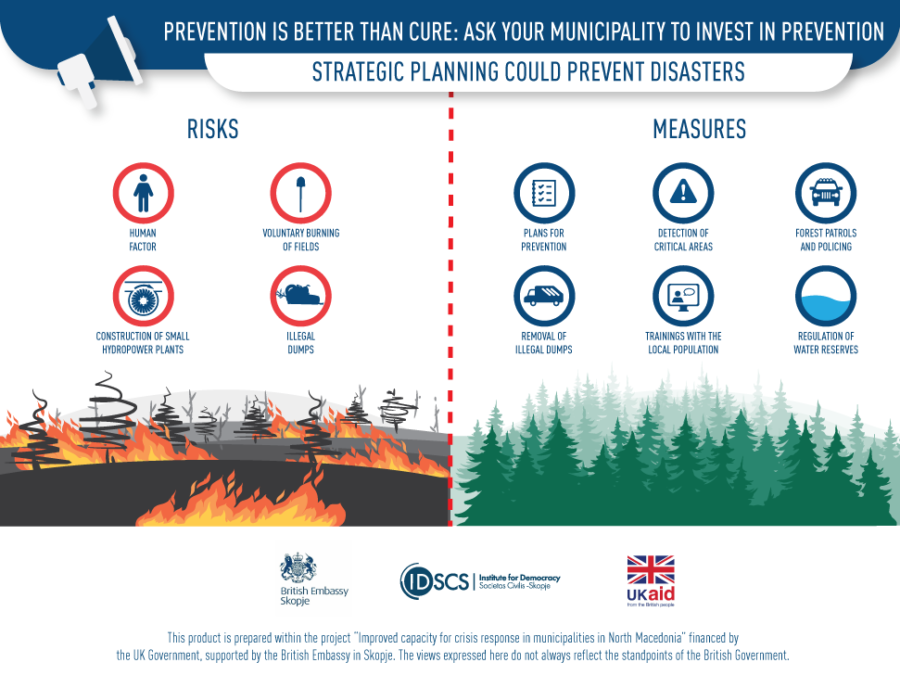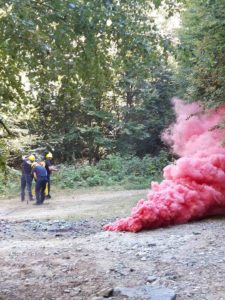11th November 2021 Skopje, North Macedonia
Building resilience to disasters through adaptation and fellowship

“The Dwarves dug too greedily and too deep. You know what they awoke in the darkness of Khazad-dum… shadow and flame..” JRR Tolkien. The Fellowship of the Ring.
The most frequently used words in the recent local election campaigns in North Macedonia have been green, humane and sustainable development. At least on paper, the political parties and independent candidates wanted to show they cater to the growing sentiment among voters that fundamental changes are necessary for the local developmental paradigm in the country. These sentiments arise from an undeniable truth that our economic development, industry growth, localities and communities increase many environmental and health risks.
The depletion of Lake Prespa, the pollution of Lake Ohrid and continuous hazardous air toxicity levels in several cities remind us of the fragility we face as a community. These are environmental crises that are long-lasting challenges that require resolute government action and investment in clean infrastructure that reduces the human footprint on the environment. At the same time, the effects of climate change can create more abrupt disasters. Globally, the incidence of extreme weather events trigger disastrous events, which in the Balkans manifested through flooding and forest fires.
These are not just events that unfortunately happen and go away. The damages caused just to the forestry from this summer’s wildfires are more than 26 million pounds. The indirect costs to healthcare, agriculture, and tourism will add to this significantly. This year’s loss to lack of preparedness dwarfs the funds dedicated to preventing forest fires.
Climate change, and extreme weather in particular, increasingly change the conditions. The new normal that everyone is talking about should trigger new adaptation policies, preparing society’s resilience to the new needs – harsher weather on one side and new environmental standards aiming to reverse the adverse effects. The point is to find new ways where economic and urban development coexist alongside improving the environment.
Such understanding of adaptation is one of the critical goals of the COP26 gathering of world leaders in Glasgow. The purpose of adaptation in this context is twofold. From one side, it is to develop preventive and defensive systems and infrastructure that are resilient to the changing climate to avoid losing lives and livelihoods. The second is to rebuild damaged ecosystems and prevent further destruction of habitats.
To achieve this adaptation, we must accept that governance must adopt a comprehensive account of risks when making decisions. The response to these new crises cannot be a simple collection of practical activities such as employment of firefighters or a timely service of firefighting airplanes. The authorities need to understand that every decision they make must follow through a risk analysis process and check if decisions to build roads, factories, residential areas, or organize public transport, for instance, do not contribute to potential disasters further on. It is a task for most institutions to adopt this kind of decision-making process and not leave it only to crisis and disaster management and safety institutions.
The first institutions in line are local governments. Disasters materialise at a certain locality and citizens expect quick action by the authorities. Local governments should have the resources to be the first responders whilst national teams come second, if the municipality cannot resolve the issue independently. But perhaps more importantly, the municipalities can prevent disasters by improving how they plan and execute their urban development, waste and water management and request that the private sector follows the same path by limiting their environmental footprint.
The Institute for Democracy worked with eight local governments to start this change in disaster governance. Helped by UK Aid and the British Embassy in Skopje, the Institute engaged the city of Skopje, and the municipalities of Veles, Kavadarci, Gostivar, Kichevo, Karbinci, Konche and Mavrovo – Rostushe to develop strategies on how to reduce disaster risks. Five of those municipalities adopted such strategies recently while the rest will follow suit in the next period.
These strategies are a necessary first step in achieving three goals.
First is to provide a framework where the local government showcases their interest in disaster risks as a municipal policy. It is a step to more decentralized risk management where local governments extend their contribution to prevention, rather than being a first respondent after a disaster struck. These activities range from adopting new tools in policy making where decisions must pass a risk analysis, to educating officials, clerks and citizens in general about disaster mitigation, protection and safety.
The second is to modernize how municipalities manage risks and crises by understanding that all disasters are artificial, so resilince is built by adapting to the multitude of natural hazards with the help of science, technology, and nature-based solutions. Take for instance landslides. They are a natural phenomenon and after eons, are responsible for some of the most breathtaking landscapes. But when they happen in a baddly planned neighborhood they are called a disaster. There are numerous cases throughout North Macedonia where entire neighborhoods are under risk for severe loss of human life because authorities have given building permits where they shouldn’t have. Extreme weather caused by climate change exacerbates this risk, contributing to fires and flooding as precursors to landslides. The strategies we devised together with municipalities call for mapping these risky areas first, and then looking into best practices on preventing erosion by employing natural solutions to reduce the risks.
The third important goal of these strategies was to have a starting point on how much disaster reduction costs. By having a systemic idea about the necessary activities, municipalities have a better picture of how much they need to invest to benefit their citizens and the environment. In some cases, these funds are very high for the modest budgetary capacity of the many municipalities in the country. But by understanding what needs to be done, local authorities can approach national or international partners and secure funding. Fitting the bill of climate change investment was an essential part of this year’s COP26, and many developed nations committed to international cooperation. While some disasters happen because of exposure to local hazards, climate change has increased new risks which need to be dealt globally through cooperation between fellow countries.
In summary, thinking about risks and preventing further environmental damage are essential parts of good governance. Better governance in this sense can lead to improved resilience of our livelihoods against hazards caused by climate change. Therefore, disaster risk reduction should be a systemic policy on all levels of governance, with clear plans and proactive investment in prevention.
Note: British Embassy Skopje offers its blog platform for guest posts. The views expressed in the guest posts are those of the authors.
